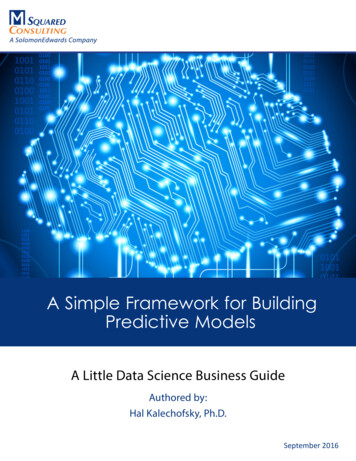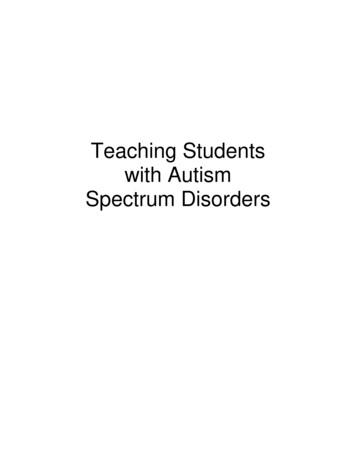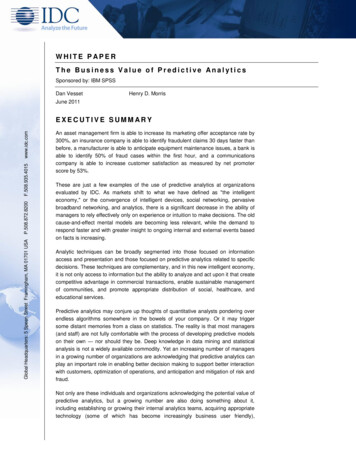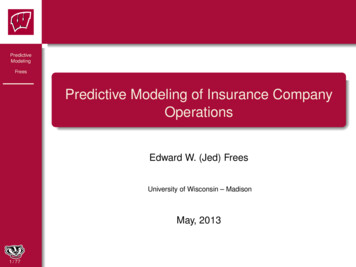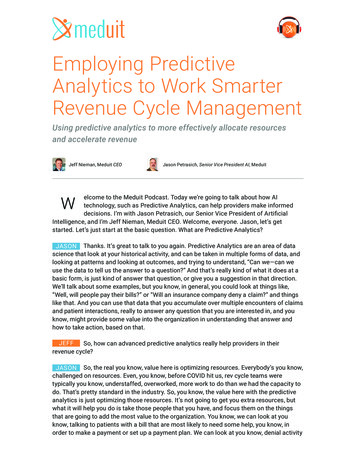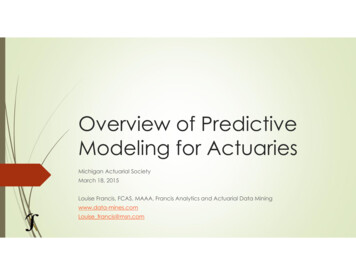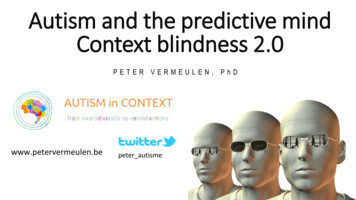
Transcription
Autism and the predictive mindContext blindness 2.0PETER VERMEULEN, PhDwww.petervermeulen.bepeter autisme
Autism friendliness An autism friendly approach startsfrom an understanding of autism fromwithin! Knowledge of “autistic thinking” is the keyto success in education and treatment!
Copernican revolution in brainscience
Default ideaabout the brain
What’s wrong with our current ideas aboutthe brain? Information processing is not linear Sense making is not just integrating all the details of the sensory input There isn’t enough time to calculate and make that puzzle! (DanielKahneman) Processing all the sensory input (computing) is not very helpful for survival!(Smilodon story) So, the brain does not compute, It guesses, And it can make smart guesses because it uses context, This is known as: the predictive mind
processingstimulusfeedbackmeaningfeedforwardSo, it does NOT work like thisbottom up top down
Checking prediction(prediction error)stimulusfeedbackpredictionfeedforwardBut it works like thisbottom up top down
The brain does notprocess stimuli, onlywhat is different fromthe stimuli itpredicted From The Lancet
We cannot avoid prediction errorsThat’s why the brain uses a variable precision of itsown predictions (and of the expected sensory input)That precision defines the filter in our brain
nstimulusno sensationno stimulussensation
Perception is controlled hallucinating.We don’t see the world, but our model of theworld.Our perception of the world is an illusionthat (in most cases, fortunately) coincideswith reality.Chris Frith
Predictive mindPredicts the sensory inputand then processes theprediction error( difference predictedand actual input)
Autism and the predictive mind: hypotheses Not enough, too broad predictions (hypo-priors) (Pellicano &Burr, 2012) Too specific predictions(Hohwy, 2015; Brock, 2012; Qian & Lipkin, 2011) HIPPEA: High, Inflexible Precision of Prediction Errors in Autism(Van de Cruys e.a., 2013, 2014) An imbalance of the precision ascribed to sensory evidencerelative to prior beliefs. (Friston e.a., 2013; Lawson, Rees &Friston, 2014)
Autism and the predictive mind: context! In ASD, the dysfunction of prediction based on context may impair theability to adapt quickly to an ever changing socio-emotional world.(Gomot & Wicker, 2012, p. 245) In particular, we think autism is associated with an inability to flexiblyadjust the degree of precision in a different context. (Van de Cruys e.a.,2013, p.97-98) Autism may be related to problems with making predictions sensitive tothe wider context.”(Palmer e.a., 2015) Comparably, reduced global processing in autism may reflect a reducedrole for top-down predictions in integrating sensory features into amore broadly coherent or context-sensitive percept.” (Palmer e.a., 2017)
Hypothesis Palmer, Lawson, Hohwy (2017)The autistic brain treats sensory input asmore informative than its own model ofthe world (based on prior information)
The weight given to sensory input or ownexpectations depends on the contextKnown environmentSensory inputOwn modelUnknown environmentSensory inputOwn modelHow much weight you give to a prediction error depends on howcertain you are about your model of the world and the predictionsbased on that model (Lawson, Mathys & Rees, 2017)
Living in a relative (VUCA) worldNothing has anabsolute meaning!Everything dependson context.contextGo back!Stop!Don’t stop!Therefore, our brainbecame an expert inusing context formaking quick andsmart guesses.
Autism as context blindnessContext blindness:Reduced ability to use thecontext spontaneously whengiving meaning to (especiallyvague, ambiguous andabstract) stimuli.
Autism as context blindness 2.0Context blindness 2.0:Reduced ability to use the contextunconsciously and spontaneously to generatepredictions about the world and processprediction errors.
Autism as a prediction disorderThis new idea could change our ideas about many things inautism such as: Sensory issues and what to do about them Communication Emotion recognition and how to teach socio-emotional skills
Our ideas aboutsensory issuesare based onthe oldcomputermetaphor
Are sensory issues really sensory?
No stronger sensory response, but strongerexperience of stimulilimbic systemInterventions should focus on the limbic system, rather than on the sensory system
The brain does not receive sensory input, it predictsit and processes the prediction errorsPredictability plays a major role in sensory issues
Sensory or anxiety and uncertainty?Small deviationsfrom predictionare noticed andprocessedHyperresponsivityHigh precision inexpectedprediction errorUncertaintyAnxiety Increased alertness
Strategies for sensory issues:traditional wayTaking esscopingBut from Hyperacusis – Tinnitus we learned: Do not eliminate sounds, but make sounds predictable andcontrollable : Working on 'feedforward' (prediction) instead of 'feedback‘(stimulus)
We need to ‘feed’ the brain so it canupdate its models and reduce theprediction errors(prediction errors stress / unpleasant)
Strategies for sensory issues?Tackle the prediction ulusStresscoping Predictability in (changes) in sensory environment Contextual clarifying of stimuli:PUSH THE CONTEXT BUTTON Changing the brains model of the world
Strategies for sensory issues?Tackle the prediction ulusStresscoping Knowing how to ‘control’ thestimulus Generating a competitive stimulus(again: predictability!)
Theimportanceof control
Understanding language and communication:old TPUTmeaning
Understanding language and communication:new modelstimulusprediction errorprediction
Context and predicting language and communicationThe brain makes quick guesses about what someone isgoing to say or show, based on context N400 N400 lower in people with autism Lexical priming(Pijnacker e.a., 2010)Jan eet friet met mayonaiseJan eet friet met schoen.
Special issue Cortex, July 2015Understanding language predicting language!
Context and communicationNothing has an absolute meaning, remember?So, whatever we use to communicate Let’sstart!wordsgesturespicturesobjects their meaning is never fixed, but depending on the context
Context and communicationWhat is difficult for people with ASD, is to findout what something (a word, a sentence, agesture, a picture etc.) means in this context
Context helps predicting communicationIf your brain is contextblind, it will havedifficulties predicting(and henceunderstanding)communication
Pushing the context button in communicationI will now askyou somethingaboutyesterdayAnd nowsomethingabout the actorsin the movieOK, Let’snow moveon toquestion #2.
Context and emotion recognitionRelation facial expression –emotion is not fixedWe never see facial expressions out of contextsadhappysadhappy
Facial expressions: inherently ambiguous!!
Recognizing MULUSmoutha bitopenmouth cornerupCONTEXT
Again: context
So, we thought emotion recognition went like this:Reading emotions FROM facesSTIMULUSmoutha bitopenmouth cornerupHe ispleased!
But it actually goes like this:Reading emotions INTO facesSTIMULUSmoutha bitopenmouth cornerupHe ispleased!
So we should teach people with autism toPREDICT emotions, using context, not faces
Predictive mind, context and socialinteractionAction perception is not simply a reflection of whathappens, but a projection of what will happen next.(von der Lühe e.a., 2016)
Context and social cognitionSocial cognition in ASD only impaired when context is involved(Baez, Ibanez et al., 2012; 2014)
Context and social cognitionSource: Baez & Ibanez (2014)
Contextualized teaching Do not use decontextualized materials Do not teach ‘skills’ but start from contexts Link behaviours always to contextscontextStarting a conversation
Pushing thecontext buttonhelps to ‘predict’an uncertainworld with all itsever changingmeanings
Hopefully you could putall the informationin context www.petervermeulen.bepeter autismeAAPC Publishingwww.aapcpublishing.net
Autism as context blindness Context blindness: Reduced ability to use the context spontaneously when giving meaning to (especially vague, ambiguous and . coping. Tackle the prediction errors! Predictability in (cha

